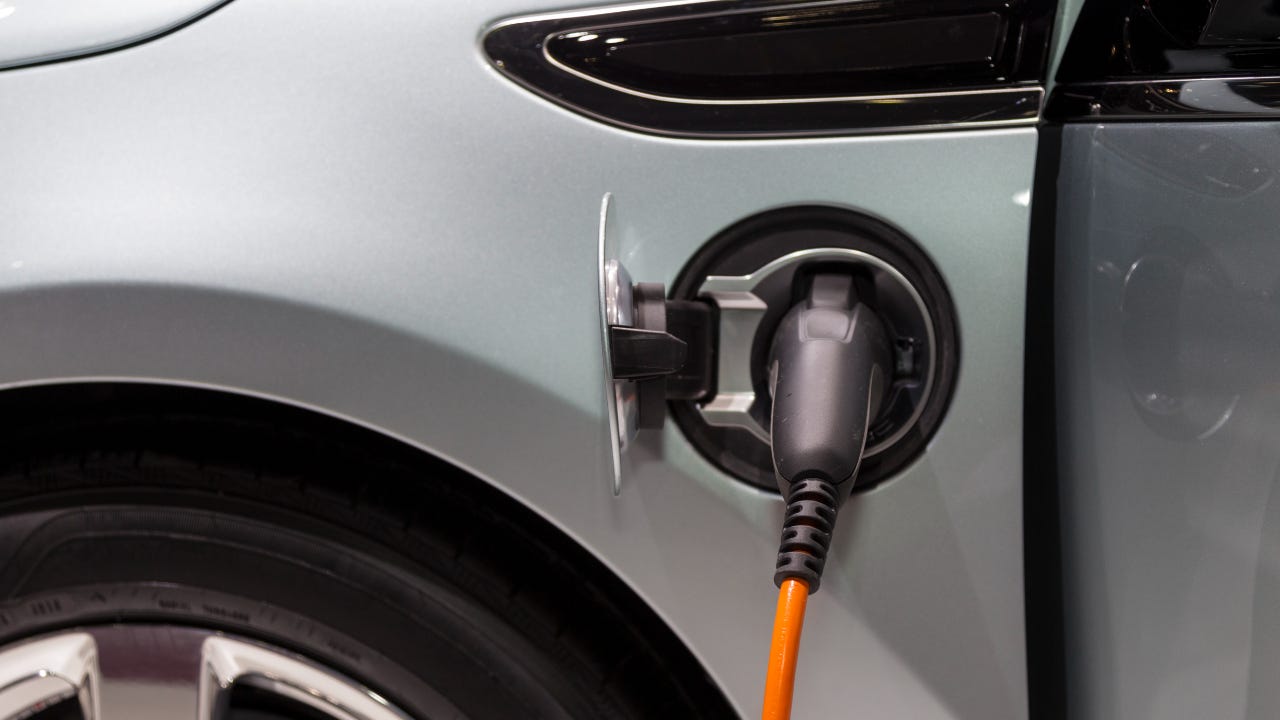EV tax credit: What to know before you buy

The Bankrate promise
At Bankrate we strive to help you make smarter financial decisions. While we adhere to strict , this post may contain references to products from our partners. Here's an explanation for .
Driving electric is no longer just for climate-conscious car buyers. The EV market has experienced dramatic growth over the past few years, with registrations increasing by 60 percent throughout 2022, according to Experian.
At the same time, electric vehicle options continue to diversify and now include a wide selection of styles, financing and price points. Driving electric also comes with many money-saving perks. Besides the obvious — saving on the cost of gas — there are electric car tax credits for those who purchase an electric vehicle. Depending on your home state, owning an electric vehicle can save you thousands.
What is the EV tax credit?
The EV tax credit is a financial incentive built by the government that will allow you to earn money back in the form of a credit, up to $7,500, if you buy a qualified electric vehicle.
Electric cars statistics
- Just over 7 percent of overall light-duty sales as of the third quarter of 2022 were electric vehicles. (Alliance for Autotive Innovation)
- California has the highest percentage of new EV registrations as of December 31, 2021, with approximately 39 percent. (U.S. Department of Energy)
- By the end of 2021 there were about 16.5 million EVs on the road. (International Energy Agency)
- About half of Americans are interested in buying or leasing an EV, up 10 percent from last year. (Jerry)
- California has the highest number of charging stations with 14,463, followed by New York, Florida and Texas. (U.S. Department of Energy)
- Tesla is the most popular electric vehicle among American consumers. (Jerry)
- Fifty-three percent of drivers uninterested in EVs worry of the inconvenience that comes with vehicle charging. (Jerry)
- Gen Z are the earliest adopters of electric vehicles, with 32 percent noting their interest in buying one in the next three years. (Jerry)
- Tesla made up 68 percent of all EV registrations in the first half of 2022. (Jerry)
- Fifty-nine percent of consumers are somewhat or extremely likely to purchase an EV (TrueCar).
EV tax credit requirements
The EV tax credit is a federal incentive built to encourage drivers to purchase an electric vehicle. This incentive is not a check you receive in the mail following a vehicle purchase, but rather a tax credit worth up to $7,500 that you become eligible for. This credit applies to all electric and plug-in vehicles, but specific credit amounts can be found via the U.S. Department of Energy’s website, fueleconomy.org.
How to qualify
Depending on the age of your electric or hybrid vehicle, to qualify for available incentives, your vehicle must meet certain specifications.
-
- Have been purchased after December 31, 2009.
- Must be a new vehicle, not used.
- Must be a purchased vehicle, not leased.
- Have a weight rating of up to 14,000 pounds.
- Hold a battery capacity of at least four kilowatt hours (kWh).
- Be for use primarily in the United States.
- For your own use, not for resale.
- Use an external plug-in recharge source.
-
- Buy it for your own use, not for resale.
- Use it primarily in the U.S.
- Have a battery capacity of at least seven kWh.
- Have a gross vehicle weight rating of less than 14,000 pounds.
- Be made by a qualified manufacturer.
- Undergo final assembly in North America.
- MSRP below $80,000 for vans, sport utility vehicles and pickup trucks and $55,000 for other vehicles.
-
- Be an individual who bought the vehicle for use and not for resale.
- Not be the original owner.
- Not be claimed as a dependent on another person’s tax return.
- Not have claimed another used clean vehicle credit in the 3 years before the purchase date.
- Have a sale price of $25,000 or less.
- Have a model year at least 2 years earlier than the calendar year when you buy it. For example, a vehicle purchased in 2023 would need a model year of 2021 or older.
- Not have already been transferred after August 16, 2022, to a qualified buyer.
- Have a gross vehicle weight rating of less than 14,000 pounds.
- Be an eligible FCV or plug-in EV with a battery capacity of at least seven kWh.
- Be for use primarily in the United States.
- Be bought from a dealer.
Income and the EV tax credit
Any driver who submits the necessary information for a qualifying vehicle using Form 8936 may be eligible for an EV tax credit. But amount of income you make can affect what tax credits you receive.
If you make a certain amount of money, more than $300,000 for married couples filing together, $225,000 for heads of households and $150,000 for all other filers, you will not qualify for tax credits.
State and local EV tax credits and incentives
Unfortunately, not every state offers EV tax credits and incentives. In fact, more than half of the states in the country do not have an EV tax credit program. So, before you set out to buy a charging station for your garage, determine how much you can save in your home state.
EV tax credits by vehicle brand
Here are some specific EV tax credits offered by vehicle brands. Just as each state differs, consider the benefits from one vehicle brand compared to another.
| Vehicle brand | Available credit |
|---|---|
| Information gathered from U.S Department of Energy | |
| Audi | $4,502 to $7,500 |
| BMW | $3,793 to $7,500 |
| Chevrolet | No longer eligible |
| Fiat/Chrysler | $7,500 |
| Ford | $4,007 to $7,500 |
| Honda | $3,626 to $7,500 |
| Hyundai | $4,543 to $7,500 |
| Jaguar/Land Rover | $6,295 to $7,500 |
| Kia | $4,543 to $7,500 |
| Mercedes | $3,501 to $7,500 |
| Mitsubishi | $5,836 to $7,500 |
| Nissan | $7,500 |
| Porsche | $3,667 to $7,500 |
| Subaru | $4,502 to $7,500 |
| Tesla | No longer eligible |
| Toyota | $2,500 to $7,500 |
| Volkswagen | $7,500 |
| Volvo | $4,585 to $7,500 |
Making the decision to buy an EV
Just as with buying a traditional gas vehicle, deciding to dive into the world of electric vehicle buying requires questioning several factors, such as cost, size and practicality. But buying an EV takes extra consideration. Here are some questions to ask yourself before deciding whether now is a good time to buy an electric vehicle.
- Is there charging available in my area? Before deciding to purchase an EV, it is important to confirm that there are available charging stations in your area. Use resources like those offered through EVgo to explore options before purchasing.
- What is the vehicle range? You will need to confirm that your new vehicle’s range fits your typical driving routine — and any trips you might be planning.
- What is the expected vehicle maintenance? While you will need to set aside some cash for service checks, you won’t have to worry about costs from oil changes or other emissions equipment.
- How much is EV insurance? The cost of EV insurance ranges so best to research and determine which lender fits best with your needs. Check out Bankrate’s guide to electric vehicle insurance.
- Should I lease an EV? Consider leasing over buying if you are able to find beneficial manufacturer incentives or if you prefer to change your vehicle every few years.
- Should I buy new or used? Weigh available incentives and your budget.
The future of EV tax credits
Electric vehicles are still some of the most expensive cars on the market, and until more are produced, they will predictably stay at a steeper price point. But because manufacturers are making green vehicles a priority, and the government is looking to reward that, the tax credit likely won’t be disappearing anytime soon. And if you have been interested in going green for a while, now might be a good time to act.
This is especially true following President Biden’s August 2021 executive order stating that half of all new vehicles sold in the U.S. should be electric by 2030. While that is quite a steep percentage jump from today, you may be able to take advantage of the current surge of electric car options and save extra money through an available tax credit.
2022 Inflation Reduction Act
Following months of deliberation, the 755-page Inflation Reduction Act passed and was signed into law by President Biden on Aug. 16. It carries the intent to “fight inflation, invest in domestic energy production and manufacturing and reduce carbon emissions by roughly 40 percent by 2030,” according to a statement from democrats.gov. The new legislation will likely affect tens of millions of Americans and encourage more drivers to buy electric and reduce carbon emissions.
The part of the legislation on clean vehicles indicates that the same $7,500 tax credit will be offered to those who purchase an EV, but stricter requirements regarding the vehicle components may make finding a qualifying EV challenging. The incentive can essentially be split into two parts.
For a vehicle to qualify for the first $3,750, a certain percentage of critical minerals used in its battery must be extracted in the U.S. or a country with which the U.S. shares a free trade agreement. The second half of the $7,500 involves where the battery components come from. Most battery components must be made in the U.S., Canada or Mexico. The required percentages of critical minerals will increase each year from 2024 to 2026, and until 2028 for components. Additionally, the vehicles must be assembled in North America.
While this creates a challenge, many manufacturers that no longer offer incentives, like Tesla and GM, will be able to resume. The legislation removes the limit on the number of EVs sold. Previously, manufacturers that sold 200,000 vehicles would no longer be eligible to offer credit.
Used EV tax credits
Another major shift following this legislation is in regards to used EV tax credits. Drivers who may not be able to afford a brand-new EV can still benefit from the tax credit. When buying a used electric vehicle costing up to $25,000, drivers can receive a tax credit of up to 30 percent of the purchase price, with a $4,000 cap.
Liz Najman, leader of policy research at Recurrent Auto, outlined how the new legislation will impact car buyers.
“Many car buyers in the U.S. can now receive up to $4,000 back on a used EV with a purchase price below $25,000,” explains Najman.
More than that, recent analysis from the reporting agency found that “almost 20% of used EVs have a price that would be eligible, and that portion of the market is only expected to grow this year,” says Najman.
“An encouraging early indicator,” says Najman, is that “already in January, about 50% of used cars checked with our eligibility tool would receive some money back.”
So while it may seem that tax credits have limited availability following the recent legislation, says Najman, “in reality, the inclusion of used car tax credits is already expanding its reach and the breadth of drivers who are able to purchase and drive an EV.”
The bottom line
If the time to purchase a new set of wheels is upon you, consider buying a new or used electric vehicle to help address climate change and benefit from EV tax credits and incentives. Before deciding on a particular EV, do your homework and investigate whether there are tax credits still available.
It’s also important to look into the availability of charging stations in your area and, depending on how you plan to use the vehicle, confirm the battery range of the EV you’re interested in.
When it comes time to find financing and insurance, compare rates and differing costs for buying EV over traditional.
FAQs about EV tax credits
-
The federal tax credit does not apply to those leasing electric vehicles. Instead, that money will go to the lessor. But this still can lower a monthly payment — if the lessor chooses to factor that incentive into your lease agreement. Mention this during negotiation to try and save money.Certain states have incentives that apply regardless of whether you are leasing or buying.
-
The credit will likely be around indefinitely, especially with increased pushes for more climate-aware vehicles. But the available vehicles are constantly shifting due to the phase-out structure of tax credits.When a particular manufacturer reaches 200,000 electric vehicles sold for use in the United States, those vehicles are no longer eligible for credits. Because of this rule, it’s important to check if the vehicle you intend to purchase is still available for credit.
-
If two members of the same household purchase electric vehicles for themselves, they can separately claim the credit for their individual cars. If the two buy an EV together, the credit may only be claimed once.
Related Articles



